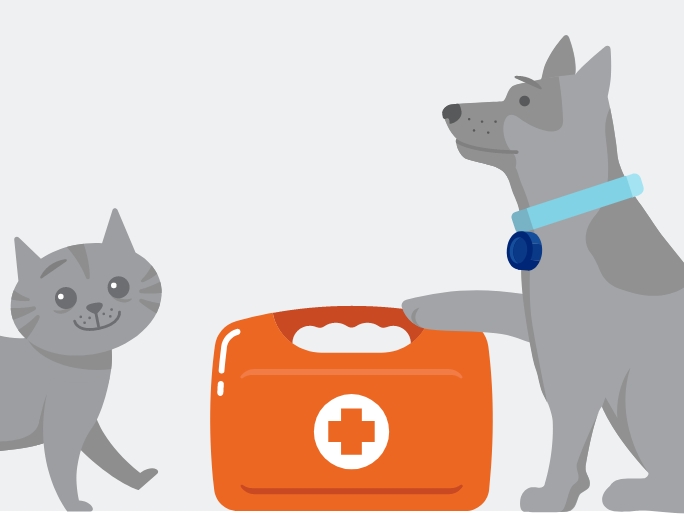skin lumps, bumps, and masses
Are you seeing or feeling lumps on your dog or cat? It’s smart to get any new bumps or masses checked out by your vet.
It’s not unusual to find a strange lump on your pet’s face or body. Here are some potential causes of bumps on skin and when to call the vet.

Possible causes of lumps, bumps, and masses
- Abscesses
- Warts
- Pustules
- Cysts
- Calluses
- Tumors
- Ticks
What’s that new lump or bump on your pet?
Technically called skin masses, lumps are very common on pets, especially dogs. Many types are benign (non-cancerous), but malignant (cancerous) growths can be dangerous and aggressive — so it’s always worth seeing your vet.

Skin masses: Masses can be big, medium, or small in size
Growths on pets can range from tiny pinpoint swellings to large lumps. Causes of benign growths could be sebaceous cysts and calluses, inflammation from an injury or infection, or even a wart or pimple.
It can be hard to tell the difference between a cancerous and a non-cancerous growth — we always recommend consulting your veterinary team.
Abscesses: An abscess is an infection under the skin
Did your pet get a cut, abrasion, or bite? Pet skin heals so quickly it can trap bacteria underneath the skin or in body tissue. This can lead to an abscess, which is a big pocket of trapped pus that cannot properly drain.
Some abscesses are a life-threatening veterinary emergency. Look for a hot, raised lump on your pet’s skin as well as pain, fever, loss of appetite, and lethargy.
If you find an abscess after Banfield office hours, take your pet to your local emergency veterinary hospital even if the wound seems to be draining. Your pet may need antibiotics, pain medication, and even surgery to remove tissues and insert a medical drain to help the infection resolve.
Warts: Warts are caused by a benign skin virus
Different kinds of warts (papillomas) are fairly common in dogs, especially on puppies with vulnerable immune systems. It’s not unusual for dogs to have anywhere from a few tiny warts to entire patches of warty skin on faces, in mouths, between toes, and pretty much anywhere else on the body.
The most common wart type resembles a pink and lumpy cauliflower. Other wart types can be dark, flat, or domed. In addition to being unsightly, warts are also contagious to other dogs. Warts on lips and feet can sometimes prevent your dog from eating, drinking, or walking normally. They may become infected or, in rare cases, become malignant.
Talk to your veterinarian if your pet has warts that interfere with their normal functions, don’t resolve on their own after two to three months, or even if you’re simply worried about them. We’re here to help with diagnosis and treatment that can help your pet.
Skin infections: Skin infections can cause lumpy pustules on pets
Skin infections (pyoderma) can cause lumpy pustules or pimples on your pet’s skin. You may see red and swollen areas, sores and scabbing, and a discharge of fluid or pus. Your pet may lose hair and have a new and unpleasant smell.
There are many causes of skin infection, including bacteria, fungus, and mites as well as allergies, hormonal imbalances, and skin trauma. If your pet has obvious skin issues, please don’t wait to see your vet! Immediate treatment can help your pet avoid becoming severely ill.
Cysts: Cysts are hollow skin pockets filled with fluid (that isn’t pus)
Cysts on pets can cause lumps on or underneath their skin. While these types of bumps are seldom malignant, it’s always worth having your veterinary team examine them (and run procedures if necessary) to make sure.
There are several different kinds of cysts, including:
True cysts
True cysts are common in both cats and dogs, especially on eyelids. This kind of cyst has a special lining and can result from a blocked duct in your pet’s eyelid or a sweat gland.
False cysts
False cysts are often the result of trauma, especially in dogs. These can sometimes resolve on their own — your veterinary team can help advise you on appropriate treatment.
Sebaceous cysts
Sebaceous cysts, commonly seen in dogs, are formed when the sebaceous gland overproduces fluid to create a lump underneath the skin. Keep an eye out for heat, redness, or discharge that may indicate an infected cyst that needs veterinary care.
Tumors: Benign and malignant tumors in pets
Tumors come in two main varieties, benign (non-cancerous) and malignant (cancerous). Please, don’t self-diagnose your pet! Benign and malignant tumors sometimes look exactly alike and can only be differentiated with laboratory testing.
Malignant tumors can be aggressive. Any new bump should be checked out by your veterinary team so we can help advise you on next steps. Even with the best care, malignant tumors can be fatal.
Common benign tumors on or below skin:
Lipomas
Seen in both cats and dogs. Slow-growing, fatty lipomas underneath your pet’s skin may feel squishy when you touch them. These tumors may be removed if they interfere with normal pet functioning.
Cutaneous histiocytoma
These surface tumors are sometimes seen in younger dogs. Your vet may suggest you keep an eye on them in case they don’t resolve and go away on their own or recommend removing them if they’re getting in your dog’s way.
Perianal gland adenomas
These tumors, which grow around your dog’s anus, typically affect non-neutered males or spayed females. Your veterinary team can help advise you on what treatments, including surgery, we recommend.
Common malignant tumors on or below skin:
Squamous cell carcinoma
This skin cancer is found on both cats and dogs. Danger signs include bald spots with small, pink ulcers and oozing sores.
Mast cell tumors
This is a cancer of the immune system. It is one of the most common cancers in dogs, often spotted when an owner mentions a new lump to their vet.
Soft tissue sarcoma
Soft tissue sarcomas can appear in any body tissue on cats or dogs, including on or underneath the skin. If you spot a growing mass, please speak to your vet.
Built-up calluses: Dogs often get calluses on skin, especially on their elbows
Your dog may have a lumpy buildup of skin called a callus on their elbow or other joints. This is perfectly normal for dogs. Even dogs with super fluffy coats may still have callouses to help protect their skin when they lie down.
Talk to your veterinary team if your dog’s calluses dry out, crack, or bleed. Like all skin breaks, cracked calluses can become infected and need veterinary care.

Mentioned in this article


Home skin and coat care
Hands-on tips for bath time, tackling fleas, and more.


Need advice on flea control? Ping Pet Chat™!
Whether it's 3 a.m. or 3 p.m., connect with a real veterinary professional for immediate petcare advice. It's included in all Optimum Wellness Plans®!
Log in to start chatting
Save at the Banfield Shop
Our mission is to provide high-quality prescription meds for the pet you love. We believe in safe, effective petcare, so we thoroughly assess every item we carry. We offer discounts on eligible products with your pet’s Optimum Wellness Plan. And you can easily schedule deliveries with our super convenient AutoShip program.
How Banfield can help with pet skin and coat care
We’re here to help your pet’s skin and coat be happy and healthy. From external parasites to skin problems to skin allergies and bumps or wounds, our vets can help with informed diagnoses and action plans to help your pet.

Get veterinary care for external parasites like fleas, ticks, and mites. From flea infestations to tick bites to ear mites and more, our vets can check out skin and coat cooties and recommend appropriate treatment. We’re happy to walk you through your options for year-round parasite control to help your pet!
Is your pet always itchy? Do you think your pet has a skin allergy? Causes for cat or dog itching and scratching can go more than skin deep. We can help figure out what’s causing your pet’s discomfort and suggest medications and treatments that can help your pet be more comfortable in their own skin.
See us for help with bald spots, shedding, greasy skin, and dandruff. Many pet health issues can affect your pet’s beautiful skin and coat. Whether it’s a flea allergy, dermatitis, seborrhea, allergies, anxiety-based issues, or other health concerns, our vets here to help with diagnosis and treatment.
Does your best furry friend have a cut or wound? Do you think they may have a tumor? Give us a call! Our vets can evaluate strange lumps and bumps and let you know if you can stop worrying. We can also help with wounds or direct you to the best resource to immediately help your pet.
 Podcast - Not Just Fluff
Podcast - Not Just Fluff



